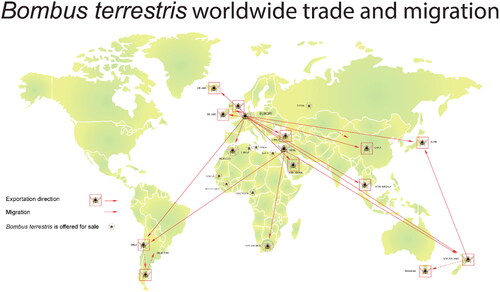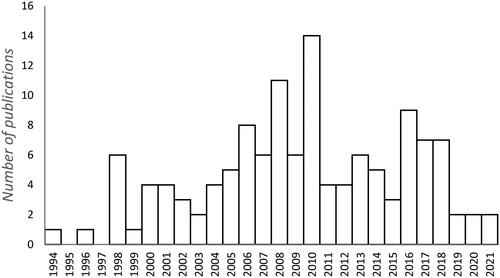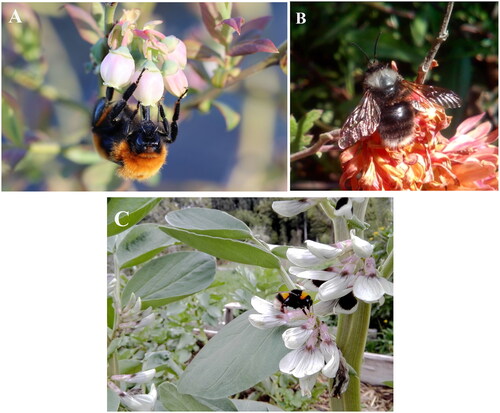Figures & data
Figure 1. Global trade map of Bombus terrestris exportation (shown with squares) from the Netherlands, Belgium (Koppert and BioBest companies, respectively), and Israel (Biobee company).
Note: Dotted circles indicate locations where B. terrestris is listed for sale, but there is no confirmation of actual importation. Uruguay and Mexico are not included, since importations were occasional and they are no longer importing. This information is limited by the availability of data for certain areas. For example, we do not include trade within the inner mainland of Europe or the occasional exportations from Spain to Chile. Exportation to Japan is restricted but not prohibited. The information presented here was obtained on official websites, social media (links derived from https://www.koppert.com; https://www.biobee.com) and scientific references (Lee and Kim Citation2019; Montalva, Arroyo, and Ruz Citation2008; Kratochwil Citation2016; Dafni et al. Citation2010). This map was modified and updated from Montalva, Arroyo, and Ruz (Citation2008).

Figure 2. Number of Bombus terrestris imported to Chile annually since 1997.
Note: Data derived from Aizen et al. (Citation2019) (1997–2009) and letters from SAG (the Chilean Agricultural and Livestock Service, 2009–2021) in both cases invoked through transparency law. The original letters from SAG in Spanish can be found at DOI:10.6084/m9.figshare.19539349. The asterisks (*) means that some colonies were destroyed by SAG because Apicystis bombi was detected in a batch from Slovakia (Koppert company) in 2020 and in a batch from Belgium (Biobest company) in 2021.

Figure 3. Annual number of publications reporting negative impacts of B. terrestris on biodiversity between 1994 and mid-2021.
Note: The complete list of publications included in this figure can be found in Supplementary Material 2.

Figure 4. Pictures of threatened Chilean bumblebees.
(A) Bombus dahlbomi in blueberry flowers. Photo by Benito Cortés-Rivas. (B) Bombus funebris. Photo by Rodrigo Barahona-Segovia. (C) Bombus terrestris (Linnaeus Citation1758) robbing nectar from a Faba bean flower and decreasing its reproductive fitness (Smith-Ramírez et al. Citation2021).

Supplemental Material
Download MS Word (62.2 KB)Data availability
All data are available in the main text or the Supplementary materials. Supplementary materials are deposited in Figshare. For details, including the relevant DOIs, please refer to the Supplementary Materials.
